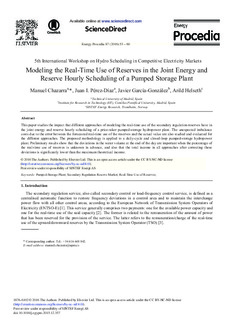| dc.contributor.author | Chazarra, Manuel | |
| dc.contributor.author | Perez-Diaz, Juan I. | |
| dc.contributor.author | Garcia-Gonzàles, Javier | |
| dc.contributor.author | Helseth, Arild | |
| dc.date.accessioned | 2016-02-04T10:46:35Z | |
| dc.date.accessioned | 2016-07-28T11:04:52Z | |
| dc.date.available | 2016-02-04T10:46:35Z | |
| dc.date.available | 2016-07-28T11:04:52Z | |
| dc.date.issued | 2016 | |
| dc.identifier.citation | Energy Procedia 2016, 87:53-60 | |
| dc.identifier.issn | 1876-6102 | |
| dc.identifier.uri | http://hdl.handle.net/11250/2397338 | |
| dc.description | - | |
| dc.description.abstract | This paper studies the impact that different approaches of modeling the real-time use of the secondary regulation reserves have in the joint energy and reserve hourly scheduling of a price-taker pumped-storage hydropower plant. The unexpected imbalance costs due to the error between the forecasted real-time use of the reserves and the actual value are also studied and evaluated for the different approaches. The proposed methodology is applied to a daily-cycle and closed-loop pumped-storage hydropower plant. Preliminary results show that the deviations in the water volume at the end of the day are important when the percentage of the real-time use of reserves is unknown in advance, and also that the total income in all approaches after correcting these deviations is significantly lower than the maximum theoretical income. | |
| dc.language.iso | eng | |
| dc.title | Modeling the Real-Time use of Reserves in the Joint Energy and Reserve Hourly Scheduling of a Pumped Storage Plant | |
| dc.type | Journal article | |
| dc.type | Peer reviewed | |
| dc.date.updated | 2016-02-04T10:46:35Z | |
| dc.identifier.doi | doi:10.1016/j.egypro.2015.12.357 | |
| dc.identifier.cristin | 1331894 | |
